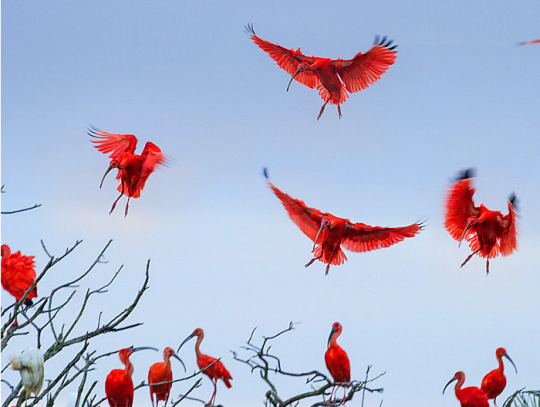#nick garbutt
Explore tagged Tumblr posts
Text

At dawn when mists often hang low over the rainforest canopy. This is Danum Valley, Borneo.
By Nick Garbutt
549 notes
·
View notes
Text

Montane Glass Frog (Centrolenella ilex)
Photo by Nick Garbutt
#glass frog#frog#frogs#montane glass frog#centrolenella#amphibians#nick garbutt#green#green frogs#nature#tropical#animals#nature photography
23 notes
·
View notes
Text

Bornean Peacock-Pheasant Feathers by Nick Garbutt
41 notes
·
View notes
Text
A song for each letter of my url.
Thanks @salty-wench @siriuslythatbitch for the tag.
How I did this? Put the letter in the my library and searched songs for one I associated with a ship. The ship thing is all me, I couldn’t work out how to choose basically.
Spanish Bombs - the Clash (Lilypad)
The Eagle and the Dove - Jessie Buckley and Bernard Butler (Sansa x Patrek Mallister)
Charlemagne - Blossoms (Regulus x Evan)
Last Nite - the Strokes (Evan(s))
Exile - Taylor Swift and Bon Iver (Jonsa)
My Lady of Mercy - The Last Dinner Party (Lilytrix)
Everlong - Foo Fighters (Rosekiller)
Notes from the Undergrowth - Gabi Garbutt (Greysnow)
There is a Kingdom - Nick Cave and the Bad Seeds (Throbb)
So Real - Jeff Buckley (Wolfstar)
So Far Away - Carole King (Jonerys)
The Circus is Leaving Town - Isobel Campbell and Mark Lanegan (Rhaelicent)
Endlessly - Muse (Bartylus)
Prioritise Pleasure - Self Esteem (Daensa)
Silver Springs - Fleetwood Mac (Theonsa)
A ship count Sansa has four, Theon, Lily and Evan fucking Rosier have three, Bellatrix is reminding me that Evan is just a name who scars noses and nothing more. There is not enough f/f on here. I do not know why.
This turned out harder than expected cos of all those ssss. And the es were tricky.
Tagging @siriusly-sapphic @thistlecatfics @thistle-and-thorn @selkiewife @towyns and obviously anyone who feels like it
There is no Hefner on here and I wish there was
5 notes
·
View notes
Text

Adult Violin Beetle (Mormolyce borneensis) on decaying leaf on the rain forest floor.
Nick Garbutt
1 note
·
View note
Text


Vancouver Coastal Sea wolves in Great Bear Rainforest, British Columbia, Canada © Nick Garbutt/Alamy Stock Photo
Today on Bing- November 7, 2024 Vancouver Coastal Sea wolves
Wolves in the wild | EN-CA, EN-CN, EN-GB, EN-US, ROW
0 notes
Photo

Vancouver Coastal Sea wolves in Great Bear Rainforest, British Columbia, Canada (© Nick Garbutt/Alamy)
0 notes
Text

Plodding along
18 notes
·
View notes
Text
Animal of the Day!
Lowland Streaked Tenrec (Hemicentetes semispinosus)

(Photo by Nick Garbutt)
Conservation Status- Least Concern
Habitat- Madagascar
Size (Weight/Length)- 280 g; 172 mm
Diet- Worms; Insects
Cool Facts- Yet another weird animal lives on Madagascar. This mammal took a rule from the amphibian handbook and it a bright yellow and black, a warning to predators. Get too close and it shows off an amazing ability. Spines hidden under its fur flare up around its body. When the spines rub together, they produce a sound too high pitched for humans to hear which it thought to ward off predators, however there is still a lack of research on these animals to fully understand the purpose of this sound.
Rating- 11/10 (Spiny boy over here trying his best.)
#Animal of the day#Animals#Mammals#Sunday#August 22#Lowland streaked tenrec#Biology#Science#Conservation#The more you know
130 notes
·
View notes
Text

Cup fungi (Cookenia sp.)
By Nick Garbutt
262 notes
·
View notes
Text

Scarlet Ibis (Eudocimus ruber)
Photo by Nick Garbutt
#Eudocimus ruber#Eudocimus#ibis#scarlet ibis#birds#red#red birds#colorful birds#flying birds#birds in flight#animals#wildlife#nature
11 notes
·
View notes
Link
I’m picking my five favorites. If you want to see all of them, click/tap.

Aye-aye (Daubentonia madagascariensis). Special ability: Poking! The long and slender fingers of the aye-aye are used to find and catch grubs (credit: imageBROKER / Alamy Stock Photo)

Red-lipped batfish (Ogcocephalus darwini). Special ability: Impersonations! The red-lipped batfish is a sad looking fish that ‘walks’ along the ocean floor (credit: imageBROKER / Alamy Stock Photo)

Goblin shark (Mitsukurina owstoni). Special ability: Bite! Razor sharp teeth of the goblin shark are perfect for biting and tearing (credit: Kelvin Aitken / VWPics / Alamy Stock Photo)

Leaf-tailed gecko (Uroplatus phantasticus). Special ability: Camouflage! With a body shaped like a leaf the gecko can blend into the background (credit: Nick Garbutt / naturepl.com)

Puffer fish (Tetraodon sp). Special ability: Poison! Puffer fish are some of the most poisonous vertebrates on the planet (credit: ephotocorp / Alamy Stock Photo)
7 notes
·
View notes
Text
A warming world gives viruses more chances to hitchhike from species to species
A warming world gives viruses more chances to hitchhike from species to species
Straw-coloured fruit bats at their daytime roosts in ‘Mushitu’ or ever-green swamp forest in April, 2014, Kasanka National Park, Zambia. | Photo credit should read Nick Garbutt/Future Publishing via Getty Images Climate change is pushing mammals into new territory, increasing the number of opportunities for viruses to jump from species to species — including humans. By 2070, if global…
View On WordPress
0 notes
Text
A warming world gives viruses more chances to hitchhike from species to species
A warming world gives viruses more chances to hitchhike from species to species
Straw-coloured fruit bats at their daytime roosts in ‘Mushitu’ or ever-green swamp forest in April, 2014, Kasanka National Park, Zambia. | Photo credit should read Nick Garbutt/Future Publishing via Getty Images Climate change is pushing mammals into new territory, increasing the number of opportunities for viruses to jump from species to species — including humans. By 2070, if global…

View On WordPress
0 notes
Text
Animated series that are unfairly being called rip-offs
It has become a regular occurrence that many people would falsely accuse of an upcoming animated series being a rip-off of existing popular series. And that too often would give the viewer an excuse by not watching it and judge for themselves, or actually doing some research, especially on the people working on them. It could also hamper the chance of a new show having a wide audience. Here are several new/recent series accused of being rip-offs of popular series:
Pinky Malinky (accused of ripping off The Amazing World of Gumball): It hasn’t premiered and yet and the upcoming Nicktoon has already been accused of this because Pinky’s art direction is reminiscent of Gumball. What gets mostly ignored, however, is that the series’ creators Chris Garbutt and Rikke Asbjoern were involved in the production of Gumball! The pilot for Pinky was produced for Cartoon Network; around the same time Gumball’s pilot was also produced and Garbutt and Asbjoern was involved in that as well. It’s also worth noting that fellow Gumball alum George Gendi will have his own series Apple and Onion premiering on Cartoon Network later this year.
Too Loud! (accused of ripping off The Loud House): Let’s see…both main characters have white hair? Both titles have the word loud on them? It’s not what you think. While The Loud House is about a boy and his ten sisters, Too Loud! is about a brother and sister who volunteer at a public library and they have big heads and loud voices, hence the title. When he got blamed for ripping off The Loud House, creator Nico Colaleo has stated that he created his characters and had even pitched the show to Nickelodeon before the network ordered The Loud House into production. Even more so, he was already an employee at Nickelodeon Animation working on Pig Goat Banana Cricket at the time. Having premiered on DreamWorks TV on YouTube, Too Loud! is currently in production for a second season for Amazon. Also, the word loud is one of the most common words used every day!
Welcome to the Wayne (accused of ripping off Gravity Falls): Nickelodeon’s latest ‘toon has been described as a blatant attempt at cashing in on Disney’s success with Gravity Falls. Wayne involves a brother and sister investigating the paranormal at a New York hotel with their new friend; however, the siblings’ last name is Timbers while the Gravity Falls’ siblings’ (and twins) last names is Pines, which raised suspicion when the names are related around trees. While Welcome to the Wayne is another series with the paranormal and other oddities as the focus, Gravity Falls is not the originator, which sadly a lot of people believe. Other popular TV series and movies in the mystery genre with paranormal activity and other oddities have been produced for years. Wayne, sadly, hasn’t become popular since the day it debuted despite praise from critics and fans alike. Its ratings were always falling behind a lot of other Nick series -- the kids are watching it, but much of the older demographics? Nope.
Sanjay and Craig (accused of ripping off Regular Show) Two buddy comedies with wacky adventures, but different shows. On Sanjay and Craig, a boy and his snake go on adventures with their friends around town with some gross out humor thrown in (in the first season at least); on Regular Show, two adult slackers are on their day job maintaining the park with weird stuff occurring. Nearly five years ago, Nick was promoting the then-new Sanjay in odd ways, and one of the promos had the titular characters reacting to each other in way similar to Mordecai and Rigby. That had many fans of Regular Show crying foul, and although both series are different visually, Sanjay was accused of ripping off Regular Show’s art direction too. But – surprise – both series had ties to each other! A few people behind Regular Show – including Madeline Queripel, Sean Szeles and Sarah OIeksyk – have worked on Sanjay and Craig! The overseas studio Saerom had provided animation for both series. Fortunately, Sanjay was a hit on Nickelodeon and was well received by critics despite scoring low from users of websites covering TV. Although its ratings tanked in the second and third seasons, Sanjay managed to finish its run on Nickelodeon while many other series went to Nicktoons to finish their runs. And for the record, Regular Show, like Adventure Time before it, didn’t originate the buddy comedy.
Fangbone! (accused of ripping off Star vs. the Forces of Evil): Back in 2016, this Canadian series received some concern of cashing in on the success of Star vs. the Forces of Evil. In Fangbone!, a boy warrior comes to live on Earth with a family while he tries to save his homeland. Fangbone makes friends with a boy in the same family, and together they go on adventures through the use of a magic portal. Sounds familiar? Surprisingly enough, Fangbone! was based on a series of children’s books published in Canada, years before we’ve heard of Star Butterfly, making it a coincidence. And more surprisingly, the TV series was picked up by Disney XD in the United States, the home of Star vs.!
Harvey Beaks (accused of ripping off The Amazing World of Gumball): Even this series was accused of it, simply because the main characters are blue, orange and pink, just like the main characters of Gumball. However, this had all but died down as the series progressed and Harvey Beaks has become the underrated gem that it is.
Can you think of other animated series that was unfairly blamed for being a rip-off of another series? Do you have your thoughts on this? Answer or reblog away! And thanks for reading!
#long post#candy randy's observations#cartoons#animation#nickelodeon#cartoon network#disney#disney xd#pinky malinky#the amazing world of gumball#tawog#welcome to the wayne#gravity falls#harvey beaks#sanjay and craig#regular show#fangbone#star vs the forces of evil#stvfoe#the loud house#too loud cartoon
358 notes
·
View notes
